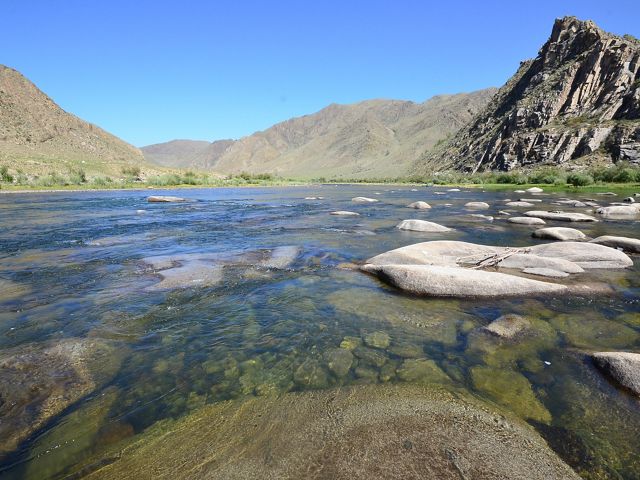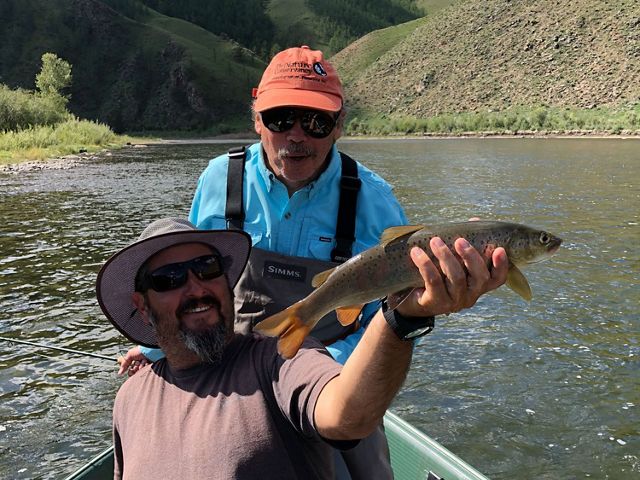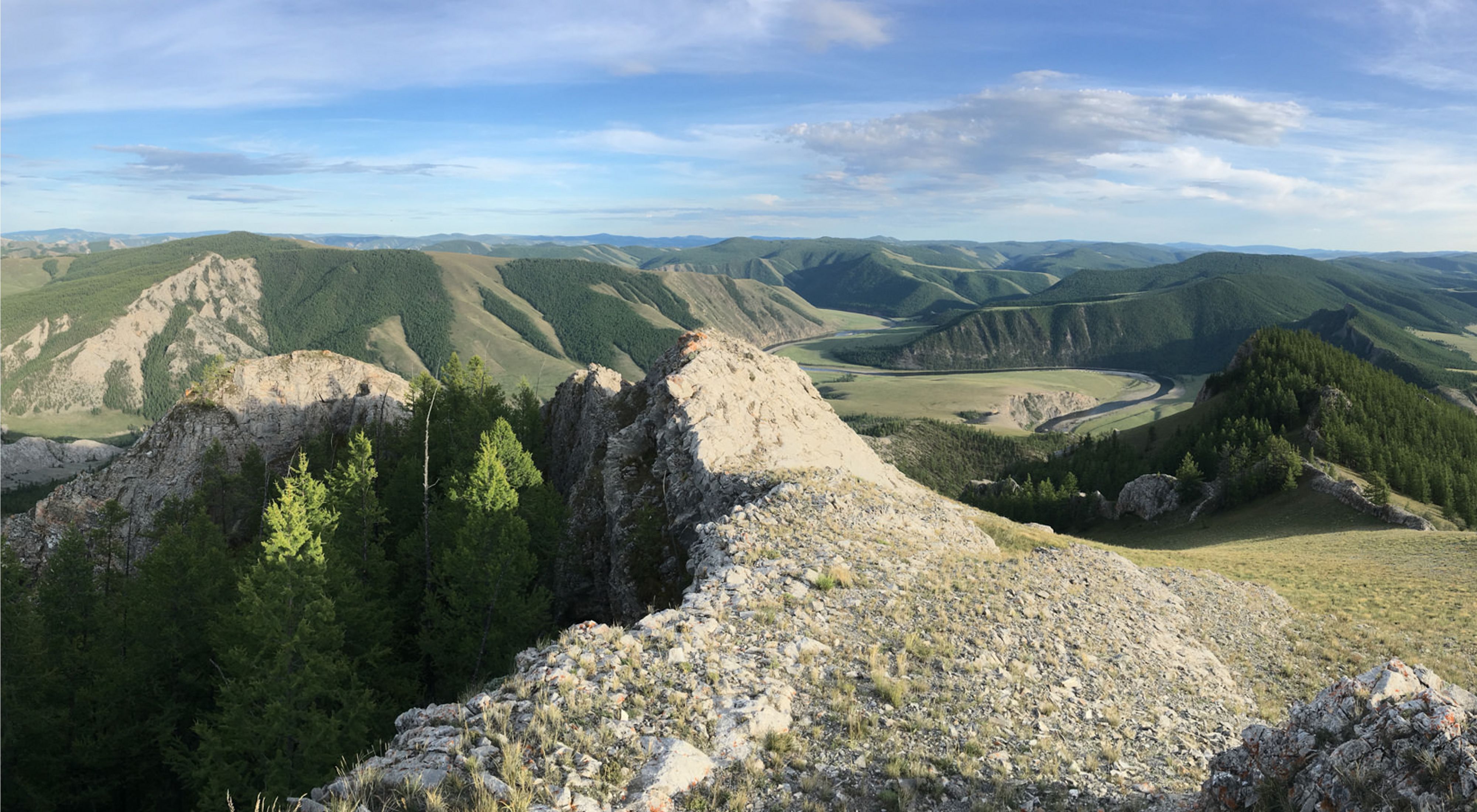The Nature Conservancy (TNC) celebrated ten years of conservation in Mongolia in 2018. To make our work come alive and give a sense of the tangible results, we took donors on an engaging field trip in northern Mongolia for sustainable fly fishing on the Delger Muron River. Participants learned about TNC’s on-the-ground work from staff and also experience why this land is so important for our mission.
Asia Pacific Council member, Tom Gorman, reflects on his impressions of Mongolia, the vast and beautiful country that TNC is privileged to help protect for people and nature.
Quote: Henry David Thoreau
Many men go fishing all their lives without knowing it is not fish they are after.
While I was growing up in the American Midwest, two writers captured my passion for nature: Henry David Thoreau (1817-1862) and Rachel Carson (1907-1964). Thoreau’s reflections on man’s relationship with the natural world called us back to a mindfully simpler, more contemplative lifestyle. One hundred years following Thoreau’s death, in 1962, Rachel Carson’s Silent Spring became the clarion call that started the environmental movement in the United States, warning us to stop taking nature for granted.
On a fly fishing float trip led by The Nature Conservancy (TNC) this August through nearly 100 kilometers of Mongolia’s pristine Delger Muron River, both of these great legacies were top of mind for me.
Our group of eight intrepid anglers from around the world were all keen fly fishermen. We were hosted by former Colorado Governor Bill Ritter, and accompanied by Charles Bedford, former Regional Managing Director for Asia Pacific for TNC, as well as Gala Davaa, now Country Director for TNC’s Mongolia Program. Our interest was piqued by the appeal of fly fishing for Mongolia’s legendary taimen (Hucho taimen), the largest salmonid on the planet, as well as plentiful, feisty lenok (a member of the trout family) and grayling.
With a total land area of 603,000 square miles and just three million people, Mongolia is the least densely populated country on Earth. Nearly half of all Mongolians live in the capital city, Ulaan Baatar. “The Land of the Eternal Blue Sky,” as it is known, features diverse landscapes: mountains and forests to the north and west, grassy steppes in the center and east, and the vast Gobi Desert to the south.
Mongolia’s 21 provinces include Khovsgol in the north, where our float trip began and ended. We flew about an hour from Ulaan Baatar to Muron, the country’s fifth-largest city (with only about 36,000 residents), and then drove about six hours on two-track roads across rolling valleys dotted as they have been for centuries with herders and their flocks. The “put-in point” for the float trip was just downstream from the high mountains of northern Mongolia, which ultimately feed into Russia’s massive Lake Baikal. There, we began our seven-day float trip through the canyons of the Delger Muron River.
The catch-and-release fly fishing was indeed spectacular as expected, but by the end of seven days on the river, our campfire conversations reflected a sense of awe at the incredible natural environment we’d become part of. It is inspiring to know that there are remote places like this where nature still rules in all her majesty, with dramatic landscapes in every direction and a beautiful river flowing through it all.
The timing of our trip was set to coincide with the 10th anniversary of TNC’s presence in Mongolia. So, at the same time, we learned from our colleagues at that economic development during the past 10 years has brought new threats and challenges to the environment—especially through mining, which accounts for 80 percent of the country’s exports—and a huge increase in livestock herd size.
In addition to an in-depth briefing and discussion over dinner with important officials from the environmental and tourism ministries, we met county-level officials and TNC community representatives from various parts of Mongolia at a special event held in Bayanzurkh, Khovsgol Province.
The reception we received from Enkhtuya Oidov, former Country Director of TNC Mongolia, and her team, reminded me of why Mongolia is famous for its hospitality. Under Enkhtuya’s leadership, the TNC Mongolia team has achieved remarkable results with limited resources in the short span of 10 years.
In planning our float trip, TNC considered its work with the Bayanzurkh community in piloting sustainable natural resource management and partnered with Mongolia River Outfitters (MRO) on the details and logistics. We fished and traveled downriver in three-person NRS inflatable rafts, manned by MRO’s expert guides. Each night, we stayed in a series of comfortable ger (yurt) camps. Our group was unanimous in giving MRO the highest marks for all arrangements, including fishing, guiding, lodging, food and logistics.
MRO has an exclusive license from the Mongolian government to fish the Delger Muron River in the summer. They are deeply committed to conservation, including strict catch-and-release fly fishing with single barbless hooks, and local community engagement to further the cause of protecting this extraordinary river.

Charles Bedford’s observations of the trip gives you a taste of this remarkable part of the world:
The Delger Muron is a big river at the put-in point. Looking down, the water runs gin clear over the cobbles. Looking up, you see where all these cobbles come from. The Delger is a subtle canyon landscape. For some hours, you float past endless prairies, then around the next bend you find a tight limestone formation, with layer lines of rock representing 100,000 years per meter, formed by the accumulation of silt and sand on the bottom of a dried-up ocean, then smashed and heated under the pressure of a tectonic plate, only to be pushed up again so the Delger can carve its way through it. This limestone mural may last for a kilometer or two. Often, you’ll see these normally straight lines undertake strange whorls and curls and bends, with the lines of each silt accumulation going from horizontal to diagonal to vertical and back again within a few hundred meters. What strange machinations! What a primeval art gallery! Wild nature has made this for us, to see back into the deep past on the walls above us.
What next? Pink granite? How did that get here, and how did we end up 700 meters deep in it? The lammergeiers soar the highest above the canyon, below them, fishing eagles and ravens nearer still — all of them finding a home in this granite. The boulders on the river bank are rounder here than the sharp fractures from the eroding limestone cliffs upstream. As we float further downriver, we lose altitude as well as moisture. That late August frost, which at the put-in point browned up what looked like Colorado Columbine flowers and something from the geranium family in a dense, wet grassland that came close to the knees, gives way to sandy granitic soil that hosts a sparser, dryer grassland still in bloom. Now we are back in the limestone. This canyon has been eroded into “penitentes” — the name given by Catholics in ancient times to the penitent pilgrims walking alone and erect across the landscape in search of forgiveness for their sins. It’s an apt name for the hundreds of jagged rock spires standing silent witness to the river, the grass, the birds, the wild and domestic animals, and, most evanescent of all, the people.
There are no people in this basin this time of year, and only the occasional herd of horses or sheep. This whole river valley is winter pasture. You’ll see evidence of an old track coming up the valley, crossing where the cliffs push the grassland into the river. The herders wait until the river freezes before they come up to spend a lonely winter up here. South-facing to catch as much sun as possible at 55 degrees north, their shelters and paddocks are perched higher up on the canyon walls and hillsides to avoid the cold air inversions. So lonely and cold in winter that it’s hard to imagine the environment offers much solace during a “dzuud,” the -50°F cold spells that come every few years to wipe out the weak in the herd. It’s lonely and beautiful now, and maybe tomorrow too.
One thing is for sure: For all of us, this was no ordinary fly-fishing trip. We caught and safely released many fish, but what each of us brought home was a profound sense of gratitude at having ventured into one of the earth’s unique environments, still pristine and breathtaking in its beauty, yet not far removed from the challenge we face on a global basis to balance the needs of nature and people.

Thomas D. GORMAN
Mr. Gorman was Chairman and Editor-in-Chief Emeritus of Fortune China magazine and CCI Asia-Pacific Ltd. Fortune China has been published by CCI under exclusive license from Time Inc. since 1996. In 2016, Time Inc. acquired CCI.
A native of Chicago and graduate of Princeton University’s East Asian Studies Department, Gorman was a Hong Kong resident since 1974. His first visit to the Chinese mainland was in 1975, and he has been a frequent visitor since that time.
A fluent Putonghua speaker, he had written and spoken extensively on doing business in China. He had been a consultant on China business strategy to various Fortune Global 500 companies.
He was past Chairman of the American Chamber of Commerce in Hong Kong, and past Board Chair of the Hong Kong International School. He was a member of the Editorial Advisory Board of The China Economic Quarterly, and the Board of Directors of The Duihua Foundation. He was a Trustee of the American Chamber of Commerce in Hong Kong Charitable Foundation, and a member of the Advisory Board of the Hong Kong Branch of International Social Service. He was a member of TNC’s Asia Pacific Council.
